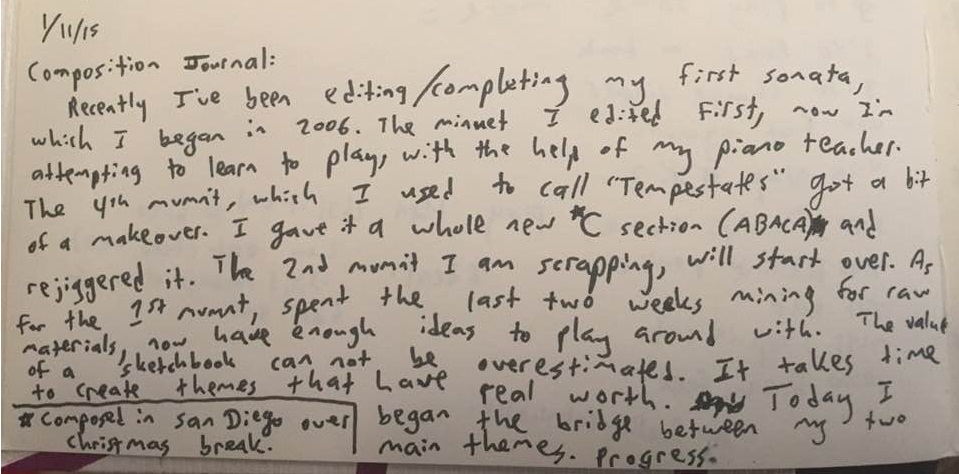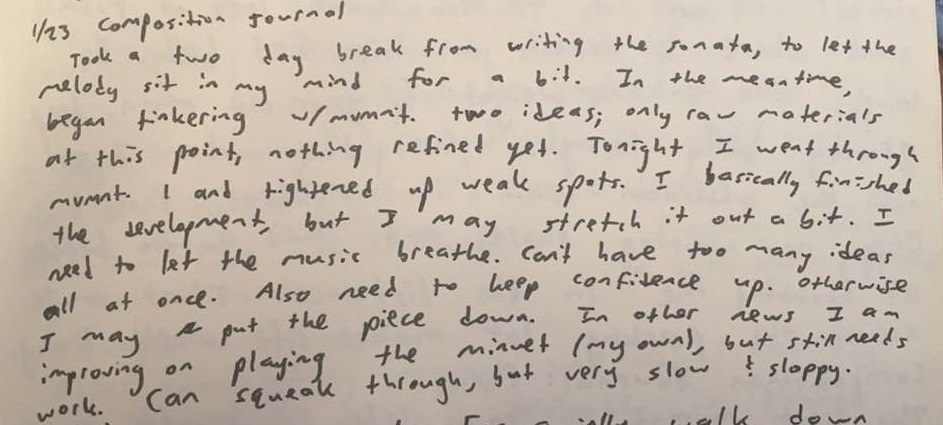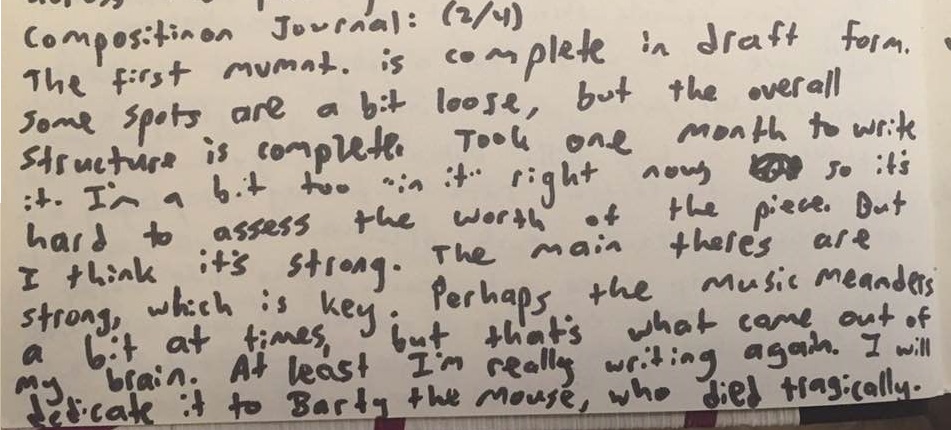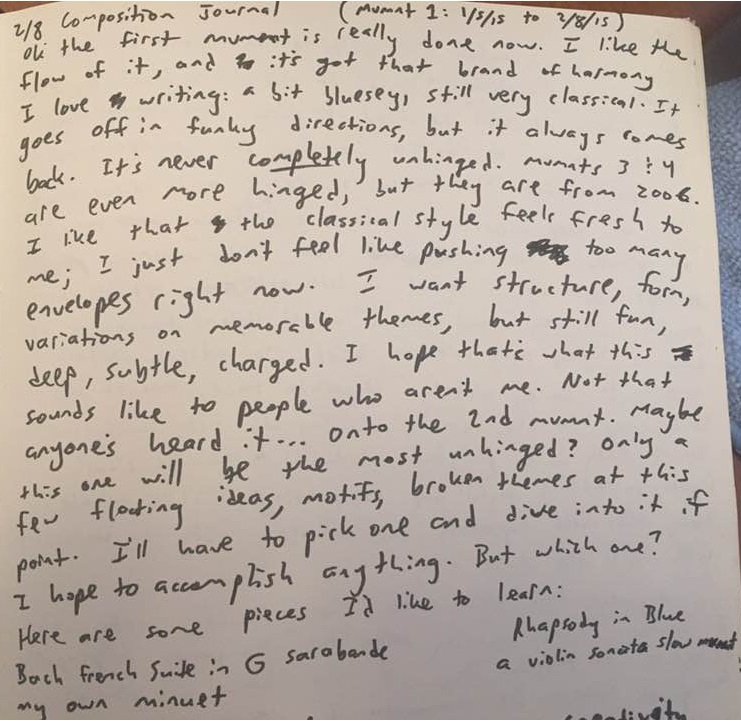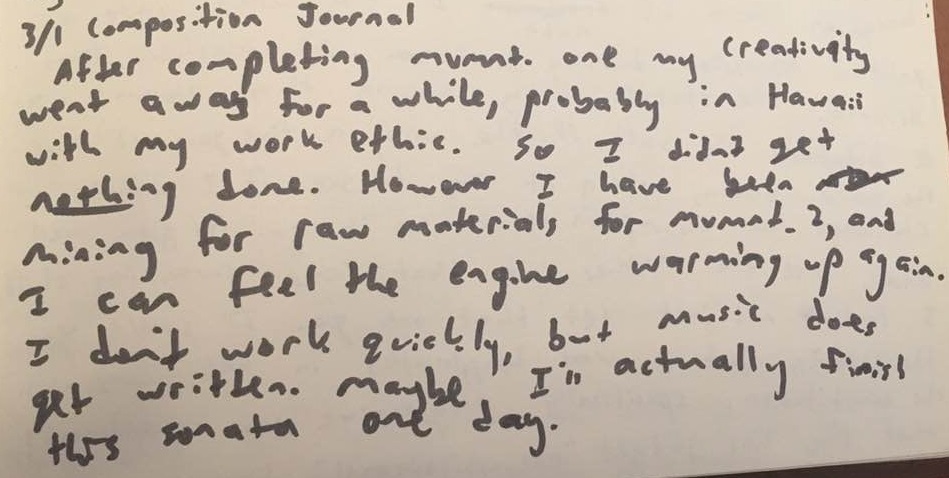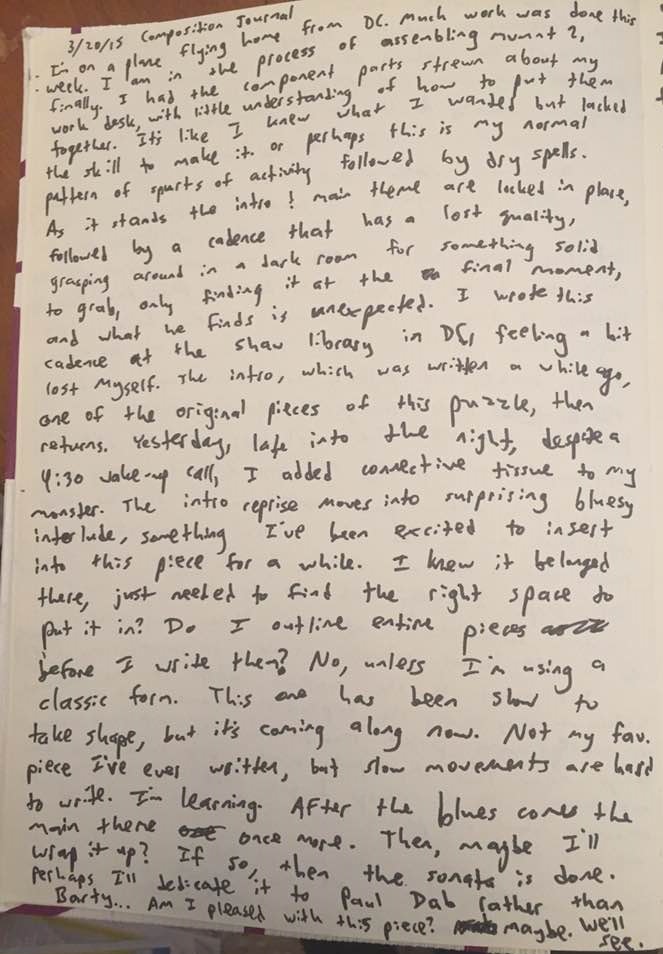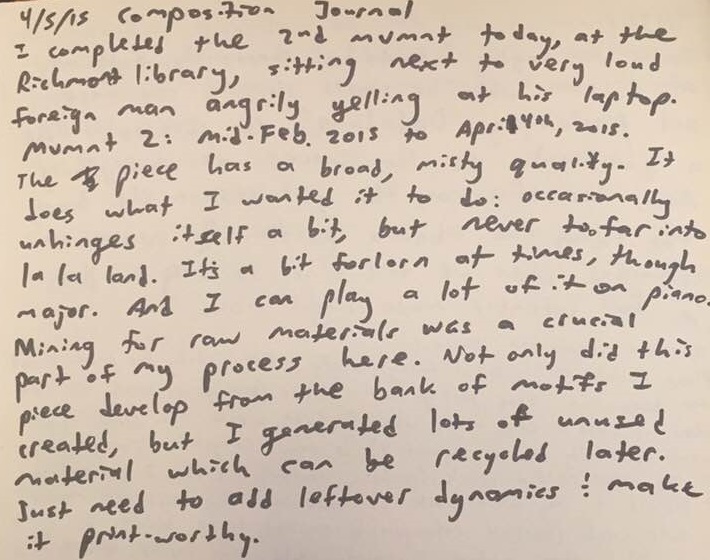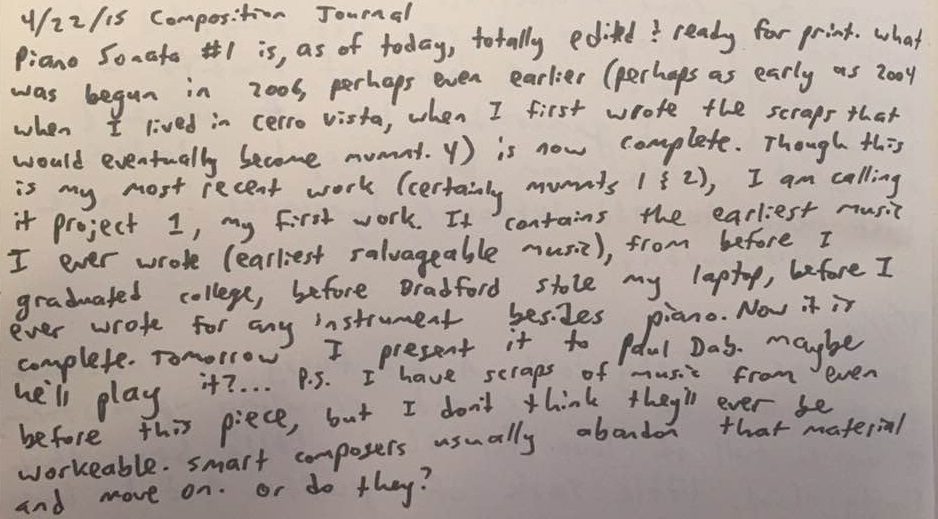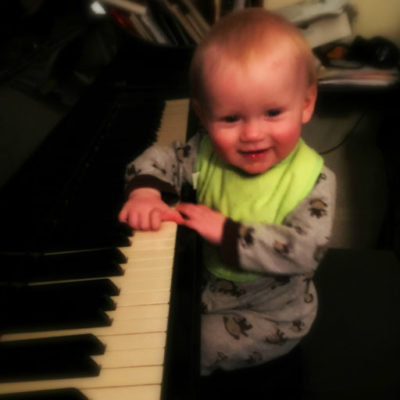My first piano sonata took me over a decade to complete. Then Jack showed up and POOF, it was done! Strange how that happens.
I always call this piece “Jack’s Sonata”, but half of the music actually predates Jack by some time. In fact, the last two movements are my earliest completed piano music. I was working on the first drafts all the way back in 2006, maybe earlier, when I was still living in the dorms at Cal Poly, a time when I knew I wanted to be a composer but had no idea how to actually write music. I remember so clearly the frustration of having music in my head, but lacking the skills to notate it. Hence, I started this music with the best intentions, but quickly became frustrated when I couldn’t finish it and tossed it in the ash heap. Luckily my ash heap is just a folder on my laptop, so the music was easily resurrected. By the time I picked it up again 10 years later, I was more properly equipped to complete the task.
So why does this music belong to Jack if it was begun long before he was born? Because Jack got me to finish it. I write such better music when I have something meaningful to write about, and there’s nothing more meaningful than the birth of my first child. The gaps I had left in the music over the years were suddenly filled in by the waves of emotion I felt as a new father. Usually I write slowly and methodically, but Jack’s presence in my life lit a fire under me and kicked off an avalanche of creative activity. Jack gave me so many new things to think about, new ways of looking at the world, new experiences. Holding a newborn brought on such a strange combination of intense love and intense uncertainty, and all of that worked its way into my music. So even though the music is older than Jack, in a certain way he owns it. I’m not sure I ever would have finished it if it wasn’t for him. His little face is imprinted on every note.
Paul Dab, my former piano teacher, also owns a piece of this music. When it comes down to it, I had fallen out of love with the piano, and Paul rekindled that fire. He made me excited about the instrument and showed me new ways to explore it. That excitement drove me to finally finish this sonata (including the composition of two brand new movements from scratch). Paul showed me how to think like a pianist again. I put my hands back on the instrument after a long hiatus, not just to tinker with chords but to play, play, play! He gave me the tools to improve my technique, both as a performer and composer, and he showed me how to write idiomatically for the piano, something that is often forgotten when writing music directly into the computer. This work would not exist in its current form without his guidance. Therefore, even though I always call it “Jack’s Sonata”, it is officially dedicated to Paul Dab.
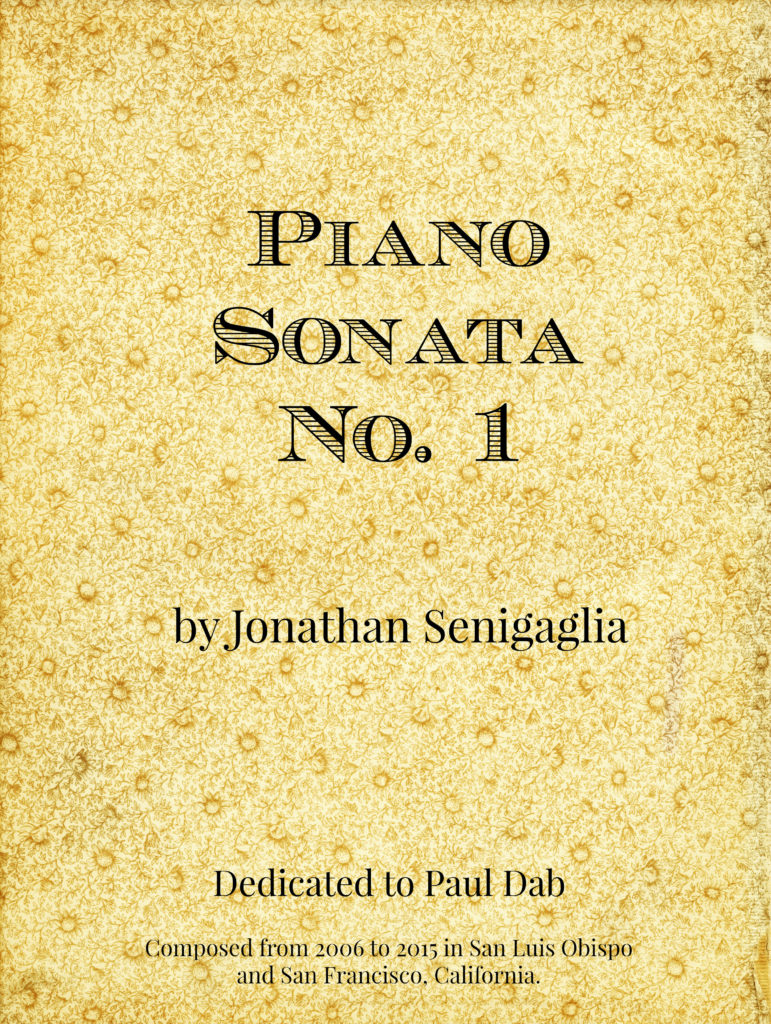
The Four Movements
Movement 1: Allegro con brio
Here’s what the first movement sounds like (computer rendition):
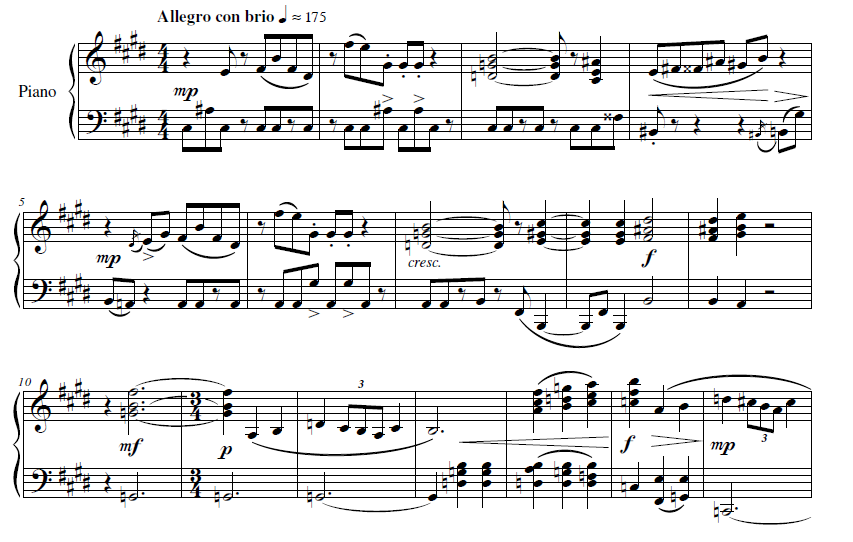
You might be thinking, “hmmm that sounds a little minor. I thought he said it was about his newborn son.” Well, yes and no. It was written right after he was born, but it’s not really ABOUT him. It’s really about me! It’s my musical reaction to some crazy-ass change happening in my life. It’s a burst of creative energy as my whole life gets flipped upside down. I think it’s fear of the unknown. It’s everything I felt when I held that precious, tiny, fragile, little nugget and pondered my place in the universe. This is an example of some music that just poured out. I had a lot of things to work out, and writing music is excellent therapy.
That being said, I still had to put a whole lot of thought into this movement. I spent hours and hours at the library hashing and rehashing ideas, experimenting and prototyping and testing ideas and staring blankly at the wall. Originally I had written an entirely different first movement way back in 2006. But when I picked this music back up in 2014, I realized that that whole thing had to go. There may have been some salvageable ideas buried in there, but I couldn’t help but see the whole thing as student work. I tossed it in the trash and started with a blank page. The music that came out of my brain belonged entirely to Jack.
This movement is highly structured, though it might not seem that way at times. Straight-forward, good old-fashioned sonata form. Ok, maybe not too old-fashioned. But really, it follows the same basic structure as the first movement of most Beethoven sonatas: Theme 1 in tonic, theme 2 in either dominant or (in this case) mediant, followed by an unstable gobblety-gook of the two themes all mixed around and intertwining, leading finally back to the first theme again in the tonic, and the lastly the second theme now transposed to the tonic. So though it may sound at times as if it contains a hundred different unconnected ideas, I assure you it is firmly rooted in classical forms.

For a first movement of a sonata, the music has got to be catchy, a bit flashy (but not decadent), and something the listener will want to hear again. For the first theme I got hooked into this angsty minor bluesy vibe that keeps falling into a mellow waltz. It can’t really make up its mind on what it wants to feel. The slightly slower second theme is cleaner, with a bass line reminiscent of a rock riff. I often find myself absent-mindedly humming this theme. It’s chipper, skippy, but never entirely major. Slices of it almost give off a pop vibe, though I made sure to end it on a sour note. These two themes are a microcosm of my psyche at the time.
Movement 2: Largo, but freely (“Jack’s Song”):
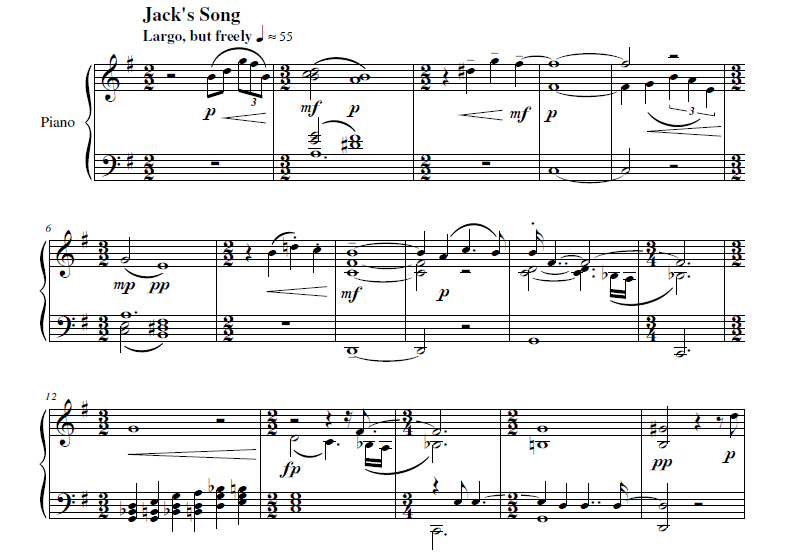
Here’s a computerized version:
And here’s a live performance from pianist Jun Cai, a student at the SF Conservatory (notice how much more flexible Jun is with the rhythm than the computerized version. There are infinite ways to interpret a piece of music):
This second movement truly does belong to Jack. As this music began to take shape, I was thinking a lot about what it means to be a father, which means my child shaped it. This music is a projection from my mind at the time, a reflection of my emotions and questions, my fear and love. The music fades in and out of coherency, at times directionless, until it finally lands on solid ground. It’s asking a question, and just as the answer comes within reach, it slips away again. This movement is tough to pin down, difficult to categorize. The music is searching, searching… It emerges slowly, pops in and out of view, like a distant ship in the mist. Sometimes it’s a love song, sometimes a lament, sometimes a hopeful look toward the future, and sometimes a lonely figure grasping for something in the dark.
I wrote a good chunk of this music in libraries, specifically the Richmond Library in SF and the Shaw Library in Washington DC. The whole ambiance of the library worked its way into this music. Libraries are bustling with activity: people walking around, searching, questioning, writing, working; children running around and older folks quietly reading the newspaper. Yet it’s also an environment where quiet reflection is of paramount importance. It’s a perfect mix of energy and silence, and I find it a very inspiring atmosphere to write music. This piece also feels to me like it is a mix of quiet and activity. I think this movement is one of my favorite things I’ve ever written… though when I first wrote about this music in my composition journal, I clearly wasn’t sure what I thought about it. (See below for the composition journal).
Speaking of my composition journal, reading the entries for this piece reminded me of how crucial sketching is when developing a new piece. I started this movement by jotting down various ideas without editing, then seeing where those ideas led. This was a period of time when the music was coming out rather quickly, and I think sketching had a lot do with that. When I’m feeling something and just need to write music, it is so important that I don’t edit myself, but instead just get everything out. Sometimes I don’t have the time or wherewithal to plan an entire piece in advance. Sometimes I just have to throw paint on the canvas then step back and figure out what shapes I created.
For example, this improv led to an important section in the piece:
And this one became the main theme (listen for Baby Jack in the background):
Movement 3: Minuet and Trio – Andante con moto
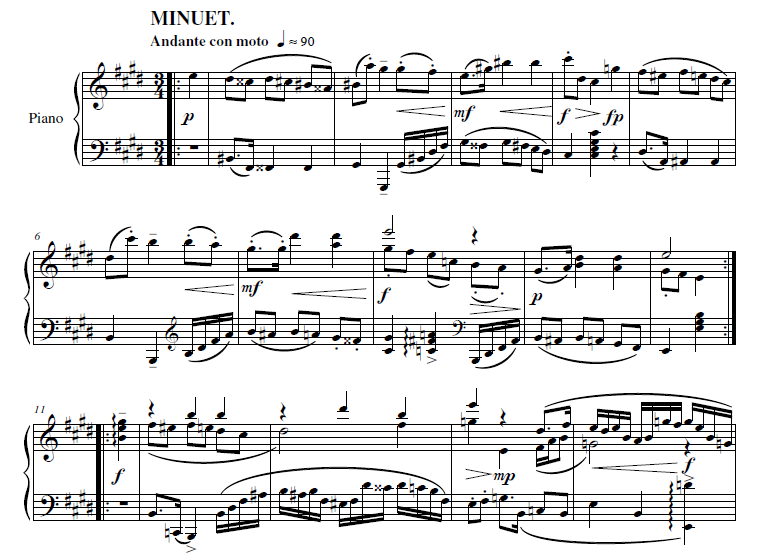
Here’ s what it sounds like, computerized:
This movement may very well be the earliest completed piano piece I ever wrote. I’m not sure exactly when I started it, because it predates my habit of keeping a journal. But I think I have a memory of working on it in 2004. I can’t be sure, but it was definitely in a semi-complete form in 2006.
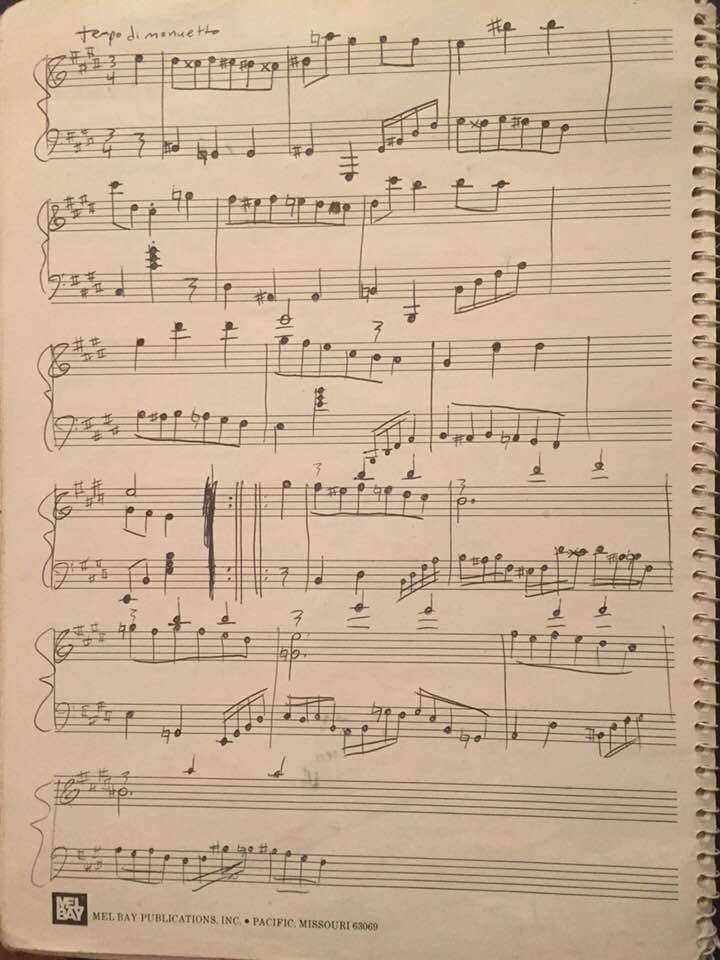
When I revisited this music in 2014, I mainly focused on adding some subtle touches to it (integrating some of the motifs into the fabric of the piece, rethinking dynamics, making it more playable). I originally picked it up again because I was looking for a piece I had written that I might actually be able to play well. This is why I give Paul Dab a lot of credit for inspiring this whole sonata. Once I started tinkering with this old nugget again, I realized I was ready to complete the entire sonata. This is the movement that jump-started it, even though it’s the simplest and more straight-forward movement of the four.
This movement is in a truly classical form: minuet and trio. A short set of Baroque dances, usually inserted into a sonata or symphony, allowed the composer to construct a stately, graceful, low-key moment of rest before the rush of the final movement. Beethoven, Mozart, Haydn and all those dudes used it many times. I really didn’t add much to the structure or push the envelope with this one. It is truly a classical piece, fairly conservative. The form looks like this:
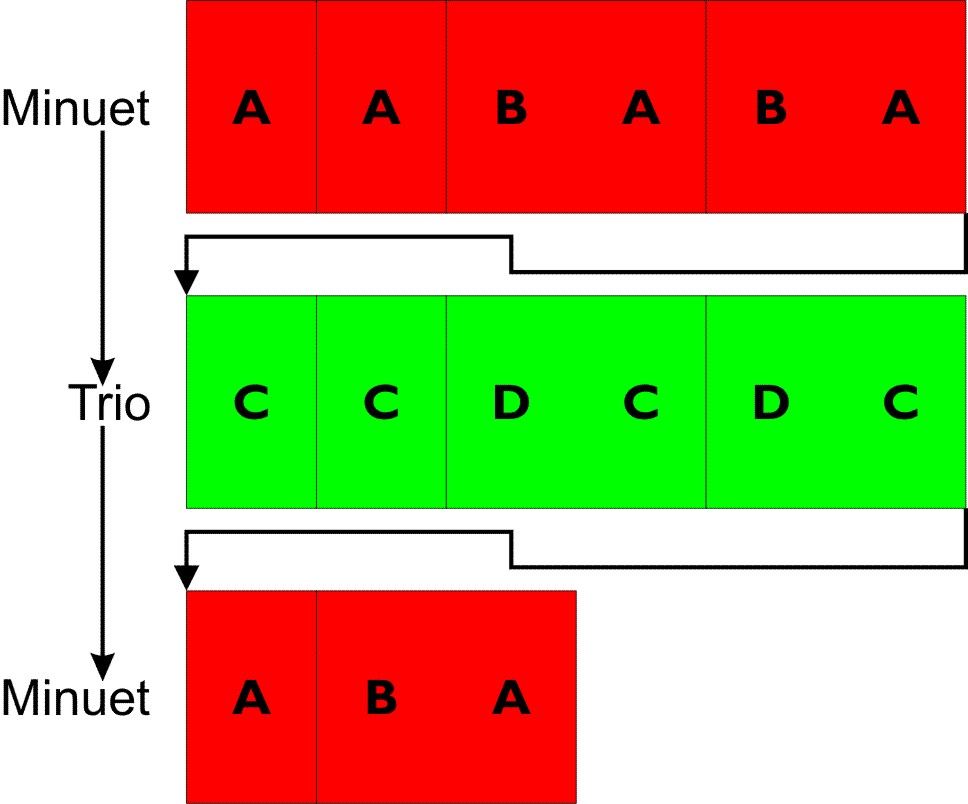
Conservative does not mean bad though. This entire sonata is full of traditional harmonies and forms, yet it still expresses what I wanted to express in that moment. This minuet is more traditional than I would probably write today, but when I started it in 2006 and finished it in 2014, that felt right in those moments. Sometimes going back to basics can unlock all sorts of new ideas.
This piece has a slight drunken quality to it, almost like the music is slurring its words. It gets a bit heated, but in a restrained way. The Trio is a bit angelic, very light, with just a flash here and there of tension. Overall, I don’t want to read too much into this one. Not all music is strictly progammatic music. When it comes down to it, this is a simple minuet and trio. I think I was playing more with form here than with emotion. This little dance is really just a calm interlude before the energetic and weighty final movement.
The minuet is nice to play though:
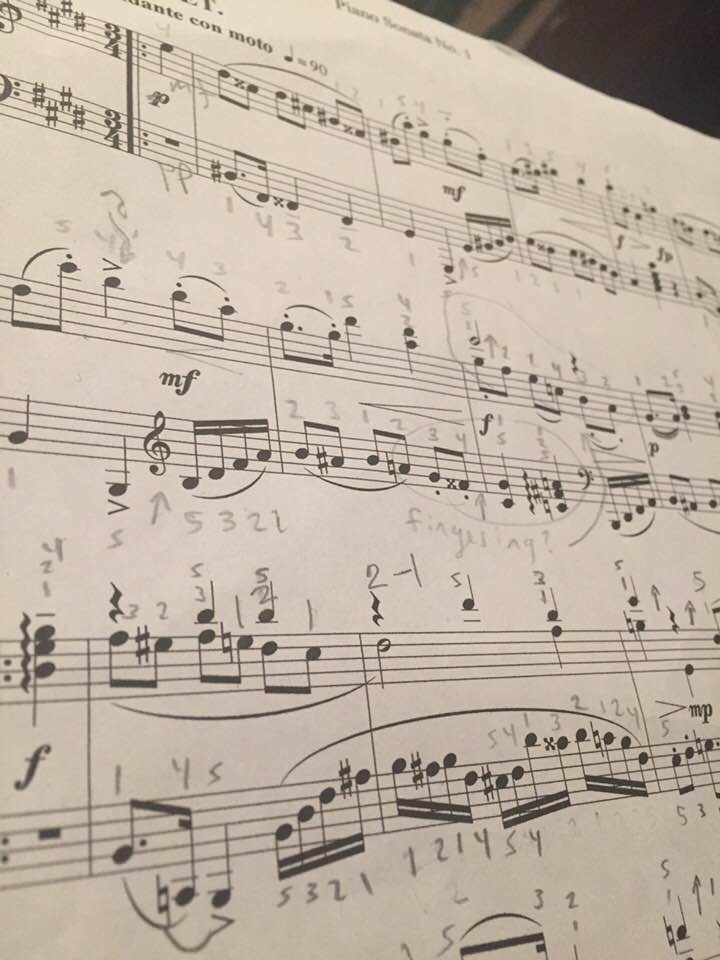
Movement 4: Rondo – Allegro Molto
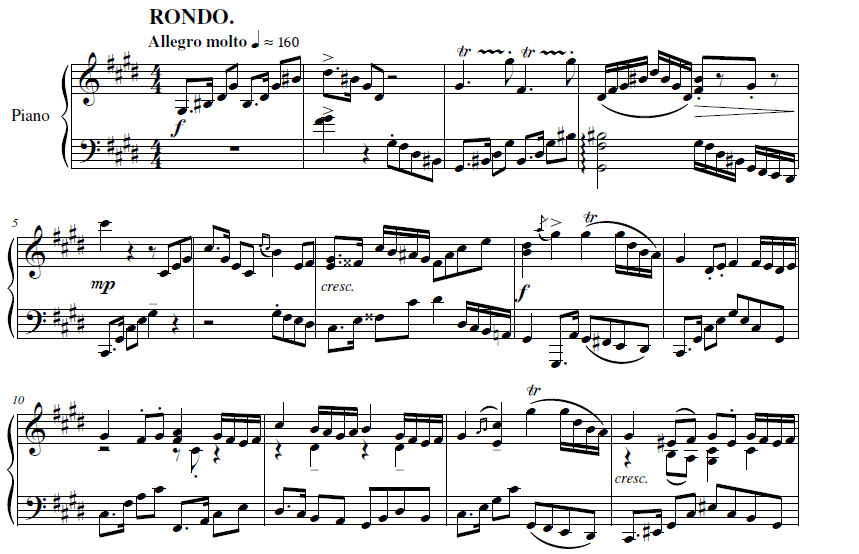
Here’s what it sounds like (computerized):
This piece is a classic. I have a vague memory of starting it way back in 2003, but I only wrote a few measures before I couldn’t find my way forward. That was when writing a simple chord progression was an uphill battle for me, so this piece was born from pure gut and intuition. Those tools will get you only so far, before technical skill is required to turn a fun little building block into an actual piece. Though I could vaguely hear this music in my head (or at least feel the emotional direction I wanted to take it in), I couldn’t figure out which chords I should use to actually express those vibes. In other words, I couldn’t compose my way out of a paper bag. This tiny nugget was all I had, so I put the piece down for a couple years and focused on learning.
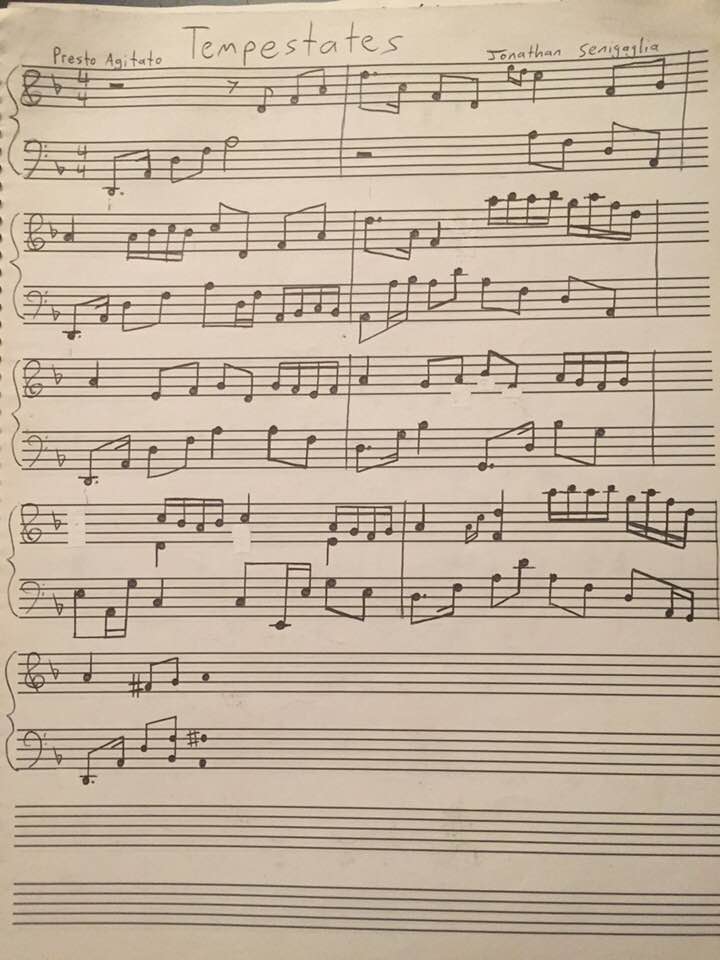
I used to call this music “Tempestates”, I think because I wanted to write a series of pieces about Greek gods or something along those lines. Instead I forgot about this music until 2006, when I was about to begin work on a final project for one of my composition classes. My professor, Meredith Brammeier (who is more responsible for my love of classical theory than anyone else on Earth) suggested that I write a medium-length piece with a clearly discernible form. After pondering my options for a bit, I rediscovered this musical fragment and thought it might make a decent rondo.
Rondo form is another classical form, usually appearing at the end of sonatas and symphonies. It goes something like ABACA, otherwise known as the deli sandwich of classical music.

This piece is very classical-sounding, or early-Romantic to be more precise. Essentially it’s in the style of Beethoven, since that’s who I was obsessed with (still am) when I was writing most of this. Back during that time, when I was still working at the Cal Poly library, I would push the cart of books around the different floors, listening to the entire catalog of Beethoven sonatas on my iPod over and over and over again, until I could hum every movement of every sonata. This Beethoven binge gave me a very strong appreciation of classical form and harmony, but also how to stretch those forms to express something deeper, how to turn form into art. Form is absolutely crucial in classical music, but it can’t be everything.
This movement probably leans more toward form for the sake of form than it does toward pure expression. As a young composer, I think I had to become proficient at form before I could wrap my head around pure expression. But built into this very structured piece is a nice dose of angst, nervous energy, and questioning, the same turbulence that guided the first two movements.
The C section is a soft interlude that plays with a couple motifs we heard earlier in the sonata. But this was not the original C section. I composed the new one mostly over Christmas break 2014 at Erica’s parents’ house in San Diego, on quiet evenings next to the giant Christmas tree, while Erica chatted quietly with her parents in the next room. The old one from 2006 was short, jolly, and fairly tight (not a lot of room to breathe). When I picked this piece up again in 2014, I probably could have expanded that old C section and gave it a bit more flair, but I decided to scrap it and start over. I wanted to write something restrained, quiet, and a bit jazzy, exactly what I wanted to listen to on those chilly winter evenings when the house was quiet.
Here’s the old C section on its own:
It’s got a bit of pep to it, but it doesn’t quite tickle me. I might salvage that one day, but for now it’s on the ash heap with so many other forgotten musical fragments.
Just for fun, here’s a video game version I made a while back:
So that’s about it for my first real-life piano sonata. Is it a perfect piece of music? Absolutely not. The final movement is too tightly wound for my taste. Were I to work on it now, I would stretch it out and let some of the ideas (and the listener) breathe a bit. I do love the first two movements, as they match my more current writing style. But as it stands they don’t exactly fit with the final two movements. This is a lesson I learned while listening to Ozma’s “Double Donkey Disk”: two very different EPs jammed together don’t exactly create an “album”. The two halves of this when taken as a whole do not feel organically written; but instead they resemble a slightly awkward arranged marriage. Which makes sense, considering the two halves were written a decade apart from each other. They are, however, united in one important way: I finished them all at the same time, motivated by the changes fatherhood brought to my life. So though the two halves aren’t necessarily united thematically, stylistically, or even artistically, they are forever united in my memories, and therefore they will remain together for eternity.
Below you will find my composition journal entries for this sonata:
